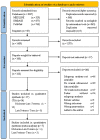Cranial Ultrasound Abnormalities in Small for Gestational Age or Growth-Restricted Infants Born over 32 Weeks Gestation: A Systematic Review and Meta-Analysis
- PMID: 36552172
- PMCID: PMC9776358
- DOI: 10.3390/brainsci12121713
Cranial Ultrasound Abnormalities in Small for Gestational Age or Growth-Restricted Infants Born over 32 Weeks Gestation: A Systematic Review and Meta-Analysis
Abstract
Aim: To perform a systematic review and meta-analysis of existing literature to evaluate the incidence of cranial ultrasound abnormalities (CUAs) amongst moderate to late preterm (MLPT) and term infants, affected by fetal growth restriction (FGR) or those classified as small for gestational age (SGA).
Methods: A systematic review methodology was performed, and Preferred Reporting Items for Systematic Review and Meta-Analyses (PRISMA) statement was utilised. Descriptive and observational studies reporting cranial ultrasound outcomes on FGR/SGA MLPT and term infants were included. Primary outcomes reported was incidence of CUAs in MLPT and term infants affected by FGR or SGA, with secondary outcomes including brain structure development and growth, and cerebral artery Dopplers. A random-effects model meta-analysis was performed. Risk of Bias was assessed using the Newcastle-Ottawa scale for case-control and cohort studies, and Joanna Briggs Institute Critical Appraisal Checklist for studies reporting prevalence data. GRADE was used to assess for certainty of evidence.
Results: Out of a total of 2085 studies identified through the search, seventeen were deemed to be relevant and included. Nine studies assessed CUAs in MLPT FGR/SGA infants, seven studies assessed CUAs in late preterm and term FGR/SGA infants, and one study assessed CUAs in both MLPT and term FGR/SGA infants. The incidence of CUAs in MLPT, and late preterm to term FGR/SGA infants ranged from 0.4 to 33% and 0 to 70%, respectively. A meta-analysis of 7 studies involving 168,136 infants showed an increased risk of any CUA in FGR infants compared to appropriate for gestational age (AGA) infants (RR 1.96, [95% CI 1.26-3.04], I2 = 68%). The certainty of evidence was very low due to non-randomised studies, methodological limitations, and heterogeneity. Another meta-analysis looking at 4 studies with 167,060 infants showed an increased risk of intraventricular haemorrhage in FGR/SGA infants compared to AGA infants (RR 2.40, [95% CI 2.03-2.84], I2 = 0%). This was also of low certainty.
Conclusions: The incidence of CUAs in MLPT and term growth-restricted infants varied widely between studies. Findings from the meta-analyses suggest the risk of CUAs and IVH may indeed be increased in these FGR/SGA infants when compared with infants not affected by FGR, however the evidence is of low to very low certainty. Further specific cohort studies are needed to fully evaluate the benefits and prognostic value of cranial ultrasonography to ascertain the need for, and timing of a cranial ultrasound screening protocol in this infant population, along with follow-up studies to ascertain the significance of CUAs identified.
Keywords: fetal growth restriction; intrauterine growth restriction; intraventricular haemorrhage; moderate-late preterm; neonate; periventricular leukomalacia; term.
Conflict of interest statement
The authors declare no conflict of interest.
Figures




Similar articles
-
The interplay between birth weight and intraventricular hemorrhage in very preterm neonates-a retrospective cohort study.Am J Obstet Gynecol MFM. 2025 Apr;7(4):101628. doi: 10.1016/j.ajogmf.2025.101628. Epub 2025 Feb 4. Am J Obstet Gynecol MFM. 2025. PMID: 39914515
-
Fetal growth restriction and intra-uterine growth restriction: guidelines for clinical practice from the French College of Gynaecologists and Obstetricians.Eur J Obstet Gynecol Reprod Biol. 2015 Oct;193:10-8. doi: 10.1016/j.ejogrb.2015.06.021. Epub 2015 Jul 2. Eur J Obstet Gynecol Reprod Biol. 2015. PMID: 26207980
-
Risk of stillbirth, preterm delivery, and fetal growth restriction following exposure in a previous birth: systematic review and meta-analysis.BJOG. 2018 Jan;125(2):183-192. doi: 10.1111/1471-0528.14906. Epub 2017 Oct 3. BJOG. 2018. PMID: 28856792
-
A systematic review on brain injury and altered brain development in moderate-late preterm infants.Early Hum Dev. 2020 Sep;148:105094. doi: 10.1016/j.earlhumdev.2020.105094. Epub 2020 May 28. Early Hum Dev. 2020. PMID: 32711341
-
Intracranial ultrasound abnormalities and mortality in preterm infants with and without fetal growth restriction stratified by fetal Doppler study results.J Perinatol. 2023 May;43(5):560-567. doi: 10.1038/s41372-023-01621-8. Epub 2023 Jan 30. J Perinatol. 2023. PMID: 36717608
Cited by
-
Screening, investigation and follow-up of neonates with small for gestational age in a metropolitan hospital in Australia-observational retrospective study.Transl Pediatr. 2024 Sep 30;13(9):1540-1550. doi: 10.21037/tp-24-83. Epub 2024 Sep 24. Transl Pediatr. 2024. PMID: 39399708 Free PMC article.
-
Efficacy of Systematic Early-Second-Trimester Ultrasound Screening for Facial Anomalies: A Comparison between Prenatal Ultrasound and Postmortem Findings.J Clin Med. 2023 Aug 18;12(16):5365. doi: 10.3390/jcm12165365. J Clin Med. 2023. PMID: 37629409 Free PMC article.
References
Publication types
LinkOut - more resources
Full Text Sources
Miscellaneous

